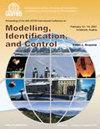基于简化风险分析的主动安全人机协作策略
IF 0.9
4区 计算机科学
Q4 AUTOMATION & CONTROL SYSTEMS
引用次数: 11
摘要
在对人机协作系统的需求日益增长的情况下,对安全机器人的需求至关重要。本文提出了一种主动策略,使机器人能够意识到当前的风险。感知是基于操作员历史占用空间的地图。该地图是基于操作员提供的每个姿势的风险评估而构建的。风险评估产生的风险域可用于评估协作任务的风险。在此基础上,提出了在任务约束条件下不断降低当前风险的控制算法。利用运动冗余来实现任务约束下的同步任务性能和风险最小化。人类和机器人都采用了基于球体的几何模型。仿真验证了该策略,并在NACHI MR20 7轴工业机器人上进行了实现和实验验证。本文章由计算机程序翻译,如有差异,请以英文原文为准。
A Proactive Strategy for Safe Human-Robot Collaboration based on a Simplified Risk Analysis
In an increasing demand for human-robot collaboration systems, the need for safe robots is crucial. This paper presents a proactive strategy to enable an awareness of the current risk for the robot. The awareness is based upon a map of historically occupied space by the operator. The map is built based on a risk evaluation of each pose presented by the operator. The risk evaluation results in a risk eld that can be used to evaluate the risk of a collaborative task. Based on this risk eld, a control algorithm that constantly reduces the current risk within its task constraints was developed. Kinematic redundancy was exploited for simultaneous task performance within task constraints, and risk minimization. Sphere-based geometric models were used both for the human and robot. The strategy was tested in simulation, and implemented and experimentally tested on a NACHI MR20 7-axes industrial robot.
求助全文
通过发布文献求助,成功后即可免费获取论文全文。
去求助
来源期刊

Modeling Identification and Control
工程技术-计算机:控制论
CiteScore
3.30
自引率
0.00%
发文量
6
审稿时长
>12 weeks
期刊介绍:
The aim of MIC is to present Nordic research activities in the field of modeling, identification and control to the international scientific community. Historically, the articles published in MIC presented the results of research carried out in Norway, or sponsored primarily by a Norwegian institution. Since 2009 the journal also accepts papers from the other Nordic countries.
 求助内容:
求助内容: 应助结果提醒方式:
应助结果提醒方式:


